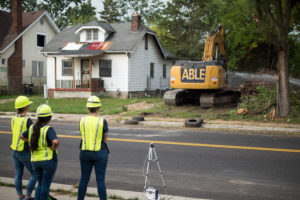Source: Michigan News

Research team members observing demolition process and attending air sampling equipment. Image credit: Sandar Bregg.

Research team members observing demolition process and attending air sampling equipment. Image credit: Sandar Bregg.
As Detroit continues to revitalize its urban core by razing abandoned buildings, emissions of airborne asbestos during emergency demolitions have been negligible, say University of Michigan researchers.
This suggests that the asbestos-related risk to human health from these demolitions—which account for about 10% of all demolitions in the city—is virtually nonexistent.
The vast majority of abandoned homes in Detroit go through asbestos abatement, or removal, before demolition. A small percentage of the structures are in such poor condition that it is unsafe for workers to go into these dwellings to assess and remove asbestos; these are called emergency demolitions.
While further research is needed, the U-M experts believe their findings—published in Science of The Total Environment—could provide evidence for the Environmental Protection Agency to ease some of the costly abatement burden for demolitions for cities around the country.
“This is evidence that we can’t just assume that asbestos is going to be released when a home is demolished and it suggests that we really probably ought to do a follow-up larger study so we can decide whether this EPA regulation that the asbestos be removed needs to be reconsidered,” said Rick Neitzel, associate professor of environmental health sciences at the U-M School of Public Health.
Read more, here.


